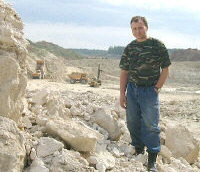Diagenesis and alteration in Kasimovian
limestones
Gzhel quarry, Gzhel village
When sediments are deposited, the spaces between grains
fill with
water. As the sediments are buried, the water provides a stimulus for
chemical reactions to occur, such as the oxidation or reduction of
compounds, dissolution of soluble materials or the breakdown of
unstable components. The result is a changing chemistry in the
sediments and fluids surrounding them, as a series of chemical
changes occurs in the sediment. This process of chemical changes is
called diagenesis.
A common change in carbonate sediments is the dissolution
of the
mineral aragonite (a common mineral in molluscan skeletons) and
opaline silica (secreted by sponges, diatoms, etc.). In the sediments
at Gzhel quarry the mineral aragonite is dissolved away, leaving
molds showing the shape of the missing fossil (especially gastropods).
Also, opaline silica has dissolved and then re-precipitated as quartz
that forms masses of chert and/or has replaced large amounts of calcite
in fossil skeletons. Chert replacement is common in the white Kasimovian
limestones and silica replacement of calcitic shell is common in both
Kasimovian and Gzhelian strata.
In addition to mineral replacement, stylolites have
formed along many
fracture surfaces in the Kasimovian limestones. Stylolites are distinctive
because solution produces very irregular surfaces with sharp points
aligned parallel to the direction of pressure; a process called pressure
solution. Small variations in the solubility of the sediment along the
solution surface create the irregularities. Stylolites occur in limestones
with little or no non-carbonate sediment.

Contact of Gzhelian strata (brown) on top of Kasimovian
strata
(white), showing fractured, weathered character of white Kasimovian
limestone and presence of large chert nodule (gray and reddish-brown)
in the limestone.

Stylolite surface on block of white Kasimovian limestone,
showing the
development of parallel needle-like projections perpendicular to the
bedding. This stylolite developed on an oblique fracture surface. The
cross-sections of many projections can be seen on the closest part of
the stylolite surface. The projections on this stylolite surface are
unusually long and slender.

Stylolite surface with short projections on block
of white Kasimovian
limestone, formed on a bedding plane containing an echinoid spine.
The coarse crystalline calcite of the echinoid spine has not been
dissolved and remains unaffected by the stylolite, contrasting with
the more soluble micrite (carbonate mud) of the surrounding limestone.

Stylolite surface formed on a bedding plane on block of white
Kasimovian limestone containing a derbyiid brachiopod. Some
of the brachiopod shell has not been dissolved, but some stylolite
spikes have cut through the thin shell of this calcitic brachiopod.

Partial silicification of a derbyiid brachiopod shell
on block of
white Kasimovian limestone. The portion of shell with bluish color is
over-thickened with silica and has a microstructure composed
of beekite rings. The portion of shell with smooth white surface is
either unreplaced calcite or has small amount of silica in the shell.

Silica-replaced rugose corals from white Kasimovian
limestone. The
entire coral is replaced with chert silica, including the chambers
between septa and dissepiments. These replacements are similar to
chert nodules, except that the margins of these replacements retain
the skeletal structure of the coral, while the structure in the coral
interior has lost during silicification.

Small chert (silica) nodules from white Kasimovian
limestone.
Note the white margins, that contrast with darker colors of the
interior of nodules.
Top
of Page
Site Search
Engine
search Carboniferous fossils of Russia or the Web
Site Links
Stratigraphy
and Sediments
Gzhel
quarry, Gzhel village
Pennsylvanian
Gzhel quarry, Gzhel village
Mississippian
Visean Stage, Aleksian-Mikhailovian substages

Home Page
Carboniferous fossils of Russia
The Pictures on this web site
are the sole
and personal property of Dr. Alexander Davydov
and Barry Sutton. Unauthorized use of any
picture(s) on this web site is Strictly Prohibited.
© All rights reserved
Contact:
Barry Sutton and Alexander Davydov
Russia@LakeNeosho.org
